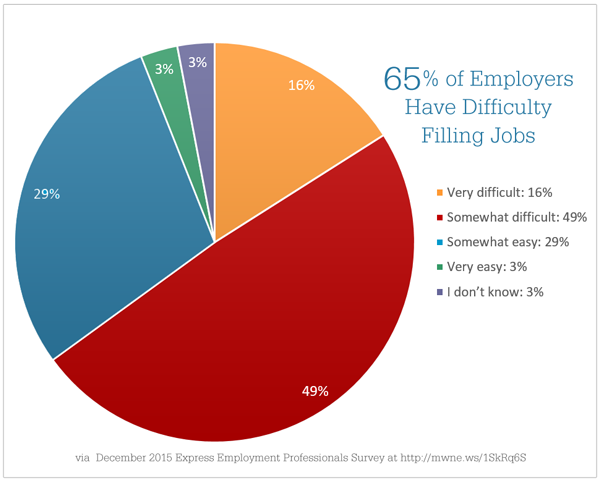Study says more than 6 in ten employers find it hard to fill open positions. Find out more about the study and get four tips for selling company culture to potential new hires, to make landing top talent easier.
Why Are Employers Having Difficulty Filling Positions?
A new Express Employment Professionals survey conducted in December 2015 found that more than 6 out of ten employers – 65 percent – said they found it somewhat or very difficult to successfully attract the right candidates in order to fill open positions. With a low unemployment rate and increased competition for highly skilled, experienced employees, HR and staffing agencies that want to win the war for talent are going to have to do more than post a position opening or job description.

Staffing Industry Analysts quotes Express’ CEO Bob Funk as saying that while there are still plenty of people who want jobs and some who have stopped looking altogether, that “part of the difficulty has been that the people who want to work may not have the skills that employers need.” For some employers, the answer when it becomes difficult to fill open positions may even be to take a risk on unskilled-but-potentially-capable workers and invest in developing employees on the job.
However, hiring for potential and training the skills needed is not always a viable option for employers. HR and staffing agencies faced with the challenge of finding candidates to fill hard-to-fill position openings can win the war for talent if they understand what candidates are looking for. Selling company culture to new hires can help sway decisions one way or another.
From the benefits offered to leader communication styles, every aspect of company culture can be transformed into an internal marketing tool that makes it easier for a business to attract and retain valuable employees. Now, let’s look closer at four specific aspects of company culture that can be used to make it easier for hiring and staffing managers to successfully fill some of those hard-to-fill position openings.
4 Ideas for Selling Company Culture to Recruits
1. What Job Titles Say About Company Culture
Job titles are important and most have specific connotations and expectations when it comes to a candidate’s perspective. For instance:
A head of department job titled “manager” instead of “director” moves its salary range into a lower level, implies more oversight and less autonomy in decision-making than for true director roles. Likewise, a department “specialist” might actually have the same responsibilities as a department manager, especially in companies with one-man departments, but would have a lower salary range; however, specialist roles like these are often great opportunities for candidates who do not quite have enough experience or training to step into a bona fide managerial role.
In both cases, the company may be communicating that they want to pay less for the same work, may limit a candidate’s ability to propose and enact change, and may have little room for advancement. Conversely, the lower job requirements may make it possible for highly competent but under-experienced candidates to prove themselves on the job and build their own career path.
Use of traditional job titles may lead candidates to believe that the organization has a traditional hierarchy and organizational chart.
Use of non-traditional job titles may lead candidates to believe that the company has a more modern organizational structure, such as a holacracy. However, use of non-traditional job titles can also create doubt in the mind of candidates relative to where the title “fits” in the organizational structure.
Candidates expect companies in creative work or innovative industries to have creative job titles that speak to the position’s practical function or the type of individual they want to fill it. Failure to deliver on this expectation could cause candidates to worry that the corporate culture is not creative-friendly.
2. What a List of Job Duties Communicates to Candidates
If a few words found in a job title can convey that much to potential new hires, what can a whole job description do? Words mean things, and the words chosen to describe a position’s role within the organization may be the only tools the HR or staffing recruiter has to win the talent war: Make them count!
The job duties or position description used in recruiting ads should tell candidates what the employer expects, how they can succeed and what will happen when they do. As with job titles, choosing to use language that is creative, traditional, formal, casual, enthusiastic, vague, specific, boring, etc., tells the prospective new hire just as much about the corporate culture as it does the position opening.
‘Type of work’ is listed as the number one factor U.S. workers consider when making career decisions, so getting the job description to successfully persuade candidates that your organization has the type of work they are looking for is critical.
Instead of following a formula, try writing job descriptions in the voice of a “real person,” describing what needs to be done in the role on an hourly, daily, weekly, monthly and/or quarterly basis. Use what you know about building buyer personas for marketing to build “candidate personas” that describe what your ideal employee type is and describe that person in your job description’s “successful candidate will be” section.
3. Are Opportunities for Advancement on the Horizon?
For U.S. workers in every generation, the opportunities for advancement available within an organization is a top consideration in deciding where to work. Large companies may have no difficulty communicating these types of opportunities to potential new hires; however, they may not be as readily apparent in smaller companies.
Take your “candidate personas” to the next step. Tell candidates what they need to succeed in the role they take, and what will happen if they do. Opportunities for advancement aren’t just about promotions. They can also be reflected in salaries, job titles, autonomy, decision-making, educational and leadership opportunities, succession planning, and more.
4. Why Would Anyone Want to Spend 8 Hours a Day (or More) on Site?
At the end of the day you want your best employees to want to come back again! The intangibles that make your company culture special are the selling points that can be used to help paint a picture for potential new hires about what a day – week – month – or year at the company will look like.
Other employees can be a great resource when you are looking for ways to describe “why” someone should want to work at your company day in and day out. Get testimonials and consider making short videos to use on sites like YouTube and LinkedIn to help get the attention of candidates and sell them on your company culture before they’ve even sent in their resume.







Leave a Reply
Want to join the discussion?Feel free to contribute!